Published by Steve Litchfield at 11:46 UTC, January 23rd 2012
Summary:
The coming of Symbian Belle, or as Nokia marketing would have you call it, 'Nokia Belle', has been much anticipated in the Symbian world, bringing a whole new scheme for working with RAM and associated performance benefits, plus more flexible homescreens, drop-down notifications pane, Android style, and a nominally 'flat' application menu, with every app in one big (and searchable) list (so you'll never again 'lose' Recorder, for example). Plus a myriad other improvements, mostly detailed below. It's a 'must' download, but what caveats are there? And what precautions should you take?
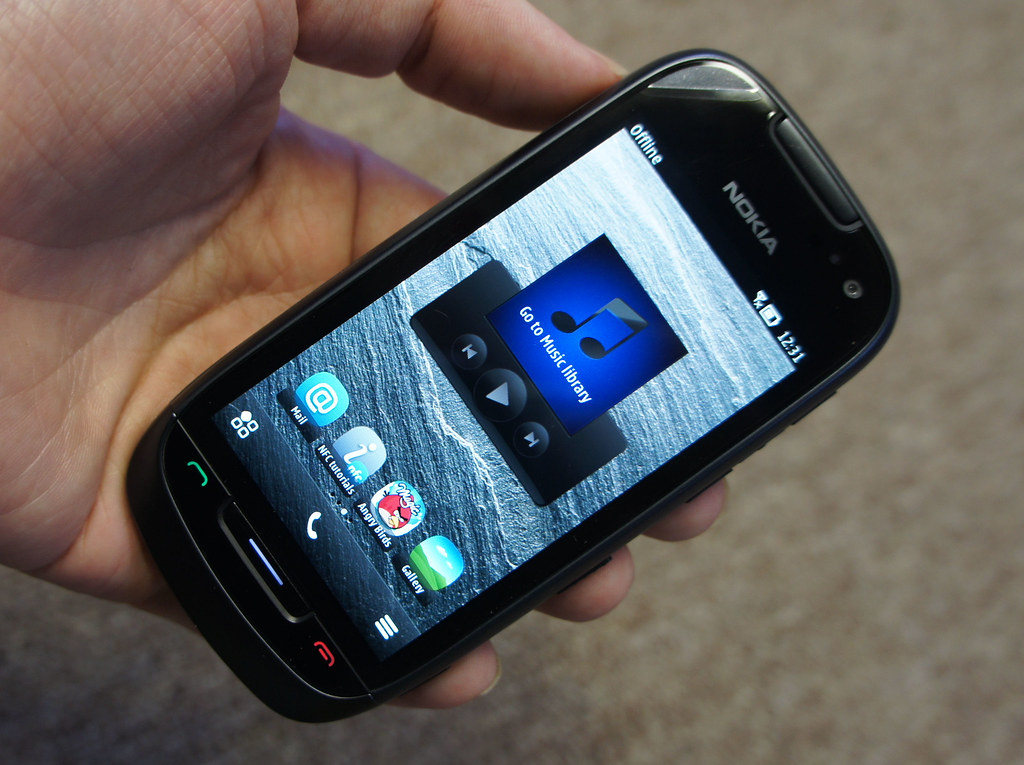
As we've reported before, there's plenty to like in this new version of Symbian. In approximate order of desirability (in my opinion!), here's a plain English changelog:
- Far better use [a new memory management scheme] of the 256MB of RAM in all Symbian^3/Anna devices. In practice this will mean no occasional 'Memory full' errors and (hopefully) foolproof execution of even the largest 'HD' games. Applications which are running will, on the whole, stay running, whatever else you start up. Overall performance is better, in terms of UI responsiveness and multitasking.
- Qt 4.7.4 is baked in from day one, meaning far fewer installation problems for Qt apps and faster (and more silent) installs in general. In addition, some applications which haven't even been available yet because Nokia hasn't been approving Qt 4.7.4-written applications for 'Anna' devices, will suddenly appear in the store. For example, CuteTube (reviewed here).
- Full NFC functionality (on the Nokia C7, at least, which has the necessary chip!), including: tap and share (share images, videos and contacts), tap and pair (pair Bluetooth accessories through a simple tap), tap and access (read tags to find information) and tap to play (unlock new levels on NFC-enabled games).
- Improvements in screen real estate, with slimmer top status bar and optional (in some apps) bottom toolbar, meaning that all phones will have a larger useful display area.
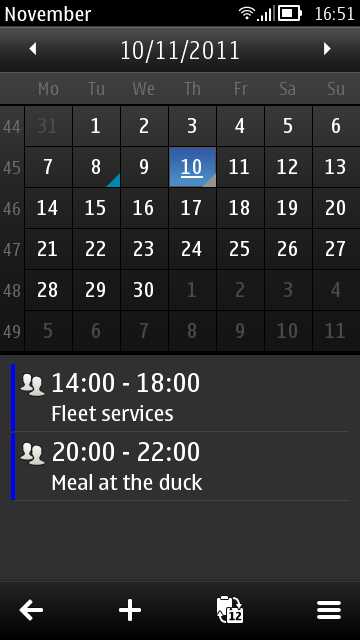
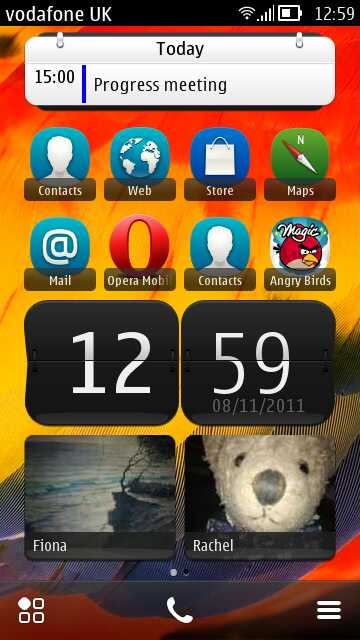
- Homescreen widgets will now come in up to five different sizes (1x1, 2x1, 4x1, 2x2, 4x4) and allow a greater degree of interactivity. For example, scrolling through new email headers, enhanced music controls, and 'toggle' widgets (allowing you to quickly switch functions on or off). In addition to dragging widgets around a homescreen in 'Edit' mode, you can now also drag from one homescreen to another. Widget re-positioning when moving from portrait to landscape mode remains intelligent, with some tweaks for the new variety in widget sizes.

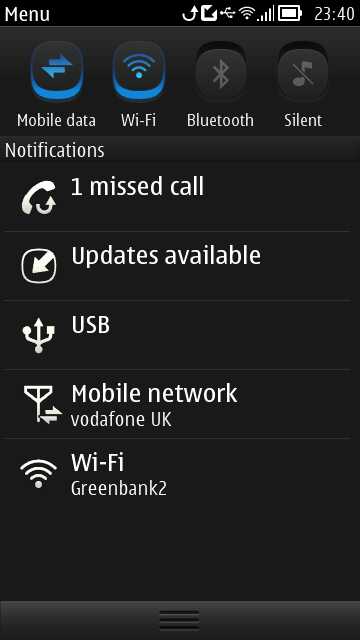
- New drop-down menu, Android style, to access notifications, connectivity toggles (including a welcome one for 'Mobile data', which previously required an involved trip into 'Settings') and system status information from most places in the UI. The layout is static, in that you can't dismiss individual items on the pane or install plug-ins, mind you.
- The Symbian homescreen system now supports up to six pages (previously the limit was three for most phones and five for the smaller-screened E6). As a fan of using just a single homescreen, I've got some rethinking to do here, but I'll get there in the end.
- A rewritten application launcher with default 'flat' structure, i.e. all applications are presented in one big scrolling grid of icons, though as I explained here, it's easy enough to make new folders, including one called 'trash' (or similar), somewhere to put all the apps you don't think you'll even need - this significantly reduces the amount of vertical scrolling needed. I'd also be tempted to make a folder for 'Games', I think. There's an option to switch the icons to alphabetic order, or to quick match/search the list, but happily your original order is also remembered so that you can switch back at any time. Newly installed applications are now marked with a red asterisk until they've been opened for the first time.
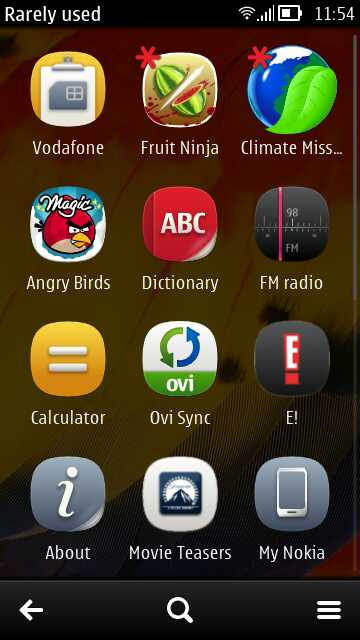
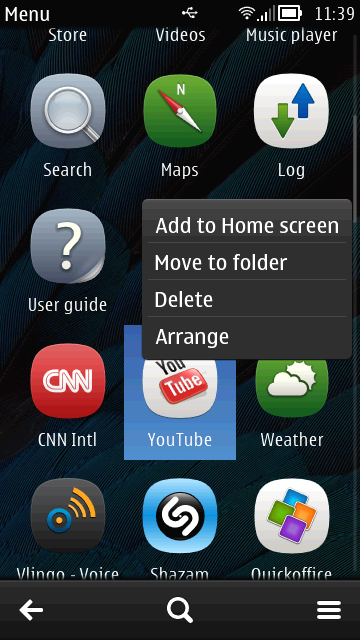
- An application can be 'added to the homescreen' from the main app menu, by long pressing its icon.
- The bottom softkeys and (optional) bottom toolbar are replaced with a single toolbar comprising up to four icons (Back/Exit, Custom 1, Custom 2, and Menu). This, for most applications, in theory, gives the UI a flatter hierarchy, with less use of menus and with more direct interaction.
- Improvements to the lock screen, which will now have information about missed calls, messages and emails. The lock screen also now supports a transparency effect, showing the underlying homescreen wallpaper.
- A new, more modern (Nokia Pure) font is used throughout the UI.
- Update to Web, with numerous optimisations and easy access to multiple windows through a permanent toolbar icon. Like desktop browsers, Web keeps track of your 'Most visited pages' and this can be set as your 'homepage' if needed. A long press and drag on web page text now pops up a 'Copy' option, for copying text to the system clipboard.
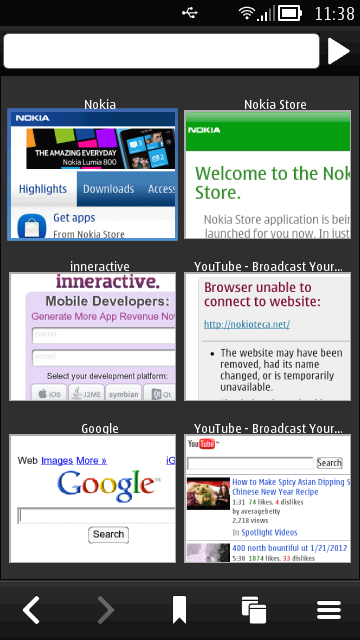

- Update to Music Player, with a 'floating track list' in the album art 'cover flow' view.
- Update to Camera, showing the new, streamlined UI that featured in the Beta Labs N8 Camera update. Although functionality is the same, far less taps are needed to get to the majority of settings and functions.
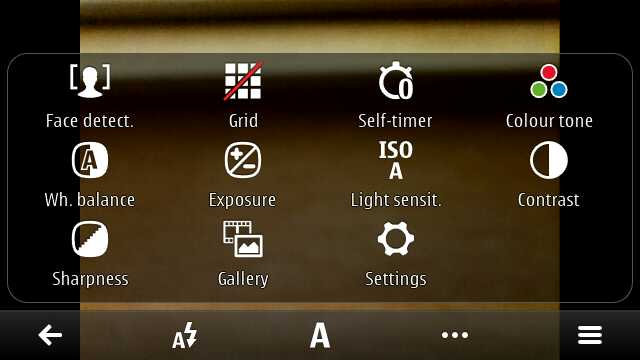
- Update to Social, probably distributed through Nokia Store (it remains to be seen what's in the final update firmware).
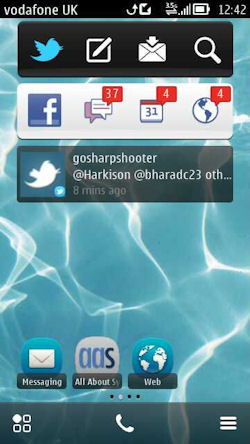
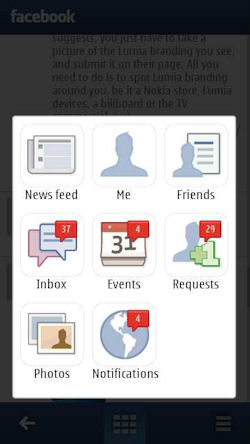
Quite a list, I'm sure you'll agree, and arguably the biggest update to Symbian since the big 'Platform Security' update and Symbian OS 9. But what about caveats? What could go wrong for you?
- Application compatibility is the biggest worry. Although there's basic binary compatibility for previous Symbian applications, the rejigged UI elements may cause cosmetic or functional problems for some third party applications, while some of the changed OS internals may cause problems for utilities and communications apps - at the time of writing, Skype still doesn't work on Belle. We're all hoping someone at either Nokia or Skype is chasing an update down as a matter of urgency.
On the other hand, there will be other applications which will only work on Belle - the new Nokia Social is a good example of this. When you visit the Nokia Store with a Symbian^3/Anna device now, you'll get a pop-up asking whether you have upgraded to Belle or not - this is explicitly because there's something of a compatibility divide for certain applications.
- Application shortcut chaos. If you've been used to a specific hierarchy of application menus (e.g. Media, Office, Games, Tools) then the new 'flat' icon menus will throw you completely. However, the chances are that you only used a couple of icons in each folder and it's easy in Belle to promote these up near the top of your 'big list' - again see my tutorial. And if in doubt, there's a big 'search' icon on the app menu toolbar, tap this and tap the first letter of the app you're looking for, etc. Or just toggle the icons (temporarily) to 'A-Z' order.
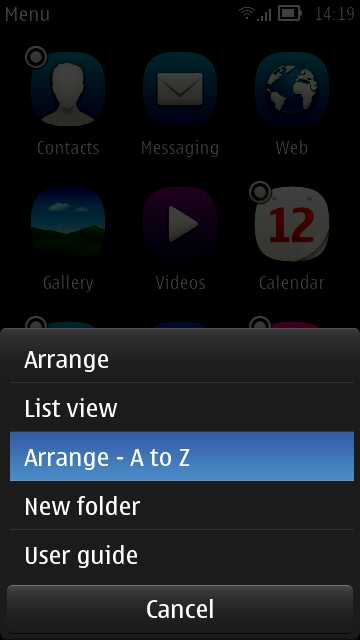
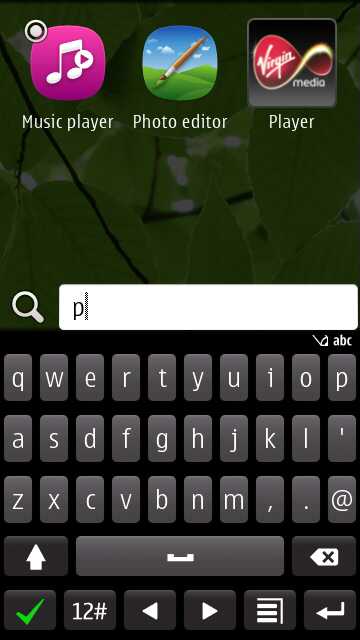
- Gremlins caused by old system files and the update process. Although I'm sure Nokia/Accenture has tested this update extensively on real world devices, I'm sure that many AAS readers are 'power users' and have pushed Symbian^3 and Anna at each stage. In other words, there will be a significant build up of old system and temporary files in a device's system (C) disk, accrued over the last year and there's always the risk that some of these may cause minor issues with the new OS.
Given that Belle effectively introduces a big UI update and that nothing's going to look the same anyway, and given that there may be some minor compatibility issues (see above), I'd give strong consideration to:
- backing up your PIM data and documents (in the usual way, to a desktop suite or to a Cloud service)
- backing up any captured photos and videos on disk E: (mass memory) - just in case
- doing *#7370# on the dialler screen, to wipe all your user data and OS settings and temporary files
- updating to Belle Over The Air or using Nokia Suite
- resyncing your data, documents and media back onto the 'fresh' installation of Belle. Most applications can be grabbed again via the Nokia Store (remember that this now lets you re-download many more times than it used to) - if an app isn't compatible with Belle then it simply won't be listed, don't worry.
Plus, the chances are that you're a bit of a geek like myself and will secretly enjoy the rebuild process to create a smartphone that's 'fresher, newer'!
Finally, if you're actually quite happy with Symbian Anna on your phone then you might even like to wait a few weeks to let others discover any more 'gotchas'. I doubt I'll be able to hold off more than a few seconds, but the old adage of 'if it's not broken then don't fix it' applies here if your N8 or C7 (etc) is currently doing what you need it to and if most of the changelog above seems somewhat unimportant to you.
The only remaining question then is timescale. When will the Symbian Nokia Belle updates start rolling out for existing Symbian^3/Anna devices? My (latest) guess is the second week in February - I'm certain Nokia wants to get it all in place for most existing devices before Mobile World Congress. Whenever the roll out starts in earnest, I'll be sure to post the news here on All About Symbian, of course.
At the very least, now is the time to do your research (starting with the piece above), now is the time to think about how you're backing up your PIM data and documents, now is the time to check you've got copies of the SIS files for important non-Store third party apps, now is the time to do backups of your backups, and so on. Belle is coming, so best be ready.
Steve Litchfield, All About Symbian, 23 Jan 2012
blog comments powered by Disqus
No hay comentarios:
Publicar un comentario